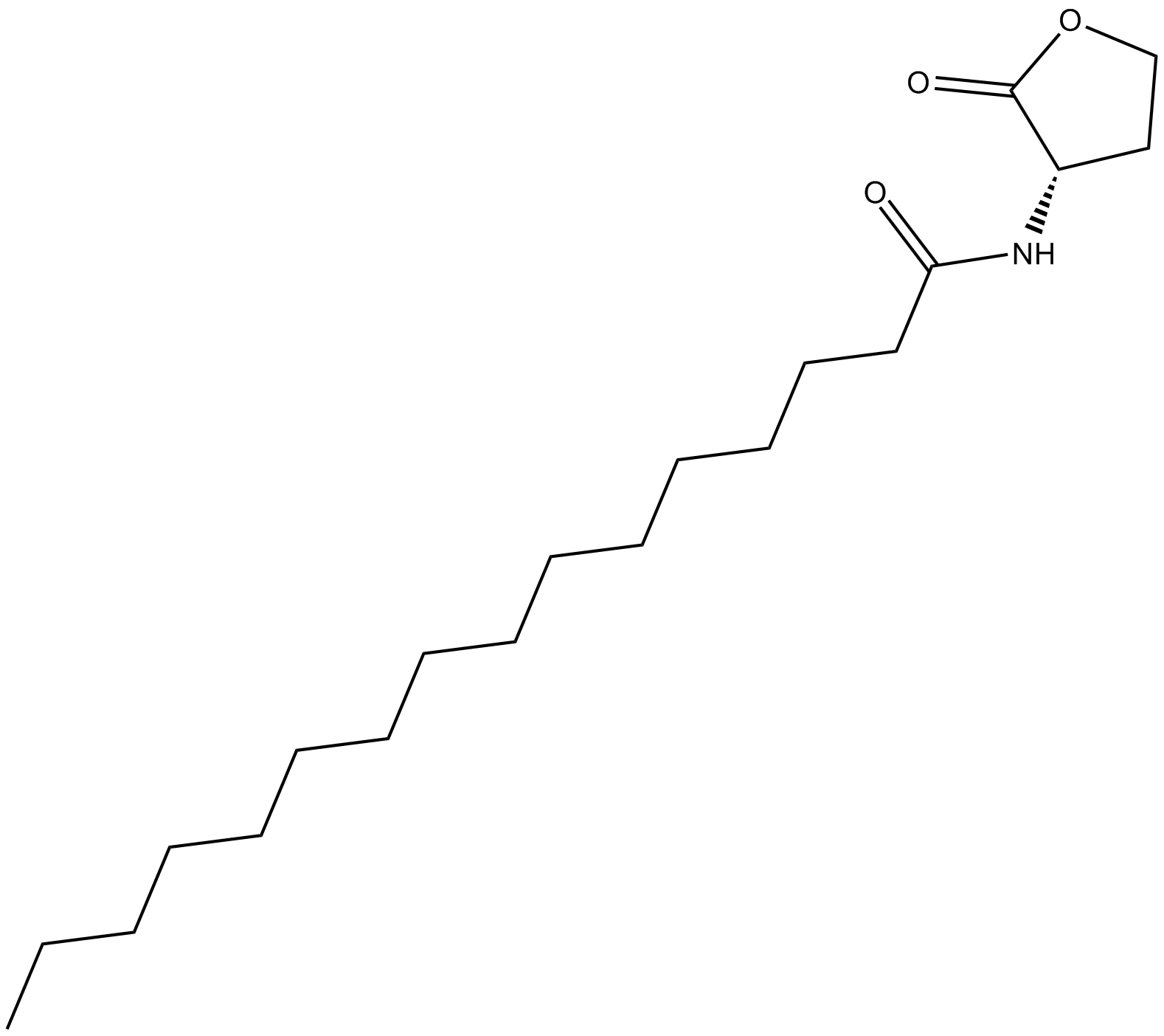N-hexadecanoyl-L-Homoserine lactone (Synonyms: C16-HSL N-palmitoyl-L-Homoserine) |
| Catalog No.GC18770 |
Quorum sensing is a regulatory system used by bacteria for controlling gene expression in response to increasing cell density
Products are for research use only. Not for human use. We do not sell to patients.

Cas No.: 87206-01-7
Sample solution is provided at 25 µL, 10mM.
Quorum sensing is a regulatory system used by bacteria for controlling gene expression in response to increasing cell density.[1] This regulatory process manifests itself with a variety of phenotypes including biofilm formation and virulence factor production.[2] Coordinated gene expression is achieved by the production, release, and detection of small diffusible signal molecules called autoinducers. The N-acylated homoserine lactones (AHLs) comprise one such class of autoinducers, each of which generally consists of a fatty acid coupled with homoserine lactone (HSL). Regulation of bacterial quorum sensing signaling systems to inhibit pathogenesis represents a new approach to antimicrobial therapy in the treatment of infectious diseases.[3] AHLs vary in acyl group length (C4-C18), in the substitution of C3 (hydrogen, hydroxyl, or oxo group), and in the presence or absence of one or more carbon-carbon double bonds in the fatty acid chain. These differences confer signal specificity through the affinity of transcriptional regulators of the LuxR family.[4] C16-HSL is one of a number of lipophilic, long acyl side-chain bearing AHLs, including its monounsaturated analog C16:1-(L)-HSL, produced by the LuxI AHL synthase homolog SinI involved in quorum-sensing signaling in S. meliloti, a nitrogen-fixing bacterial symbiont of certain legumes.[5],[6] C16-HSL is the most abundant AHL produced by the proteobacterium R. capsulatus and activates genetic exchange between R. capsulatus cells.[7] N-Hexadecanoyl-L-homoserine lactone and other hydrophobic AHLs tend to localize in relatively lipophilic cellular environments of bacteria and cannot diffuse freely through the cell membrane. The long-chain N-acylhomoserine lactones may be exported from cells by efflux pumps or may be transported between communicating cells by way of extracellular outer membrane vesicles.[8],[9]
Reference:
[1]. González, J.E., and Keshavan, N.D. Messing with bacterial quorum sensing Microbiol. Mol. Biol. Rev. 70(4), 859-875 (2006).
[2]. Gould, T.A., Herman, J., Krank, J., et al. Specificity of acyl-homoserine lactone syntheses examined by mass spectrometry Journal of Bacteriology 188(2), 773-783 (2006).
[3]. Cegelski, L., Marshall, G.R., Eldridge, G.R., et al. The biology and future prospects of antivirulence therapies Nature Reviews.Microbiology 6(1), 17-27 (2008).
[4]. Penalver, C.G.N., Morin, D., Cantet, F., et al. Methylobacterium extorquens AM1 produces a novel type of acyl-homoserine lactone with a double unsaturated side chain under methylotrophic growth conditions FEBS Letters 580, 561-567 (2006).
[5]. Gao, M., Chen, H., Eberhard, A., et al. sinI- and expR-dependent quorum sensing in Sinorhizobium meliloti Journal of Bacteriology 187(23), 7931-7944 (2005).
[6]. Teplitski, M., Eberhard, A., Gronquist, M.R., et al. Chemical identification of N-acyl homoserine lactone quorum-sensing signals produced by Sinorhizobium meliloti strains in defined medium Archives of Microbiology 180, 494-497 (2003).
[7]. Schaefer, A.L., Taylor, T.A., Beatty, J.T., et al. Long-chain acyl-homoserine lactone quorum-sensing regulation of Rhodobacter capsulatus gene transfer agent production Journal of Bacteriology 184(23), 6515-6521 (2002).
[8]. Pearson, J.P., Van Delden, C., and Iglewski, B.H. Active efflux and diffusion are involved in transport of Pseudomonas aeruginosa cell-to-cell signals Journal of Bacteriology 181(4), 1203-1210 (1999).
[9]. Mashburn-Warren, L., and Whiteley, M. Special delivery: Vesicle trafficking in prokaryotes Molecular Microbiology 61(4), 839-846 (2006).
Average Rating: 5 (Based on Reviews and 26 reference(s) in Google Scholar.)
GLPBIO products are for RESEARCH USE ONLY. Please make sure your review or question is research based.
Required fields are marked with *




















